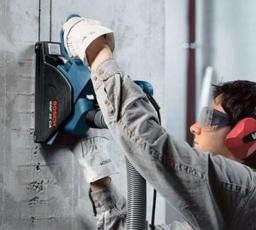Search
Login
Strobing walls for wiring, how to do it correctly, tools and devices for strobing
Repair in an apartment or your own house is a pleasant and useful business, but quite troublesome, you have to deal with many issues, make sure that you do not miss essential things for quite important details. After all, it concerns the repair not only of updating walls, floors and ceilings, but also the improvement of utilities, in particular - electrical wiring.
This question should be emphasized especially, if only for the reason that with the growth of well-being and the development of scientific and technological progress, more and more useful equipment appears in our house every year, which makes life more comfortable and domestic work easier. Electrical appliances connected in the premises have sufficient power and create significant loads on the wiring in the house.
In addition, the addition of new outlets will allow you to abandon the use of extension cords with adapters and splitters.
Content
- How to prepare for work
- Wall chipping for electrical wiring - get acquainted with the basic rules
- Strobing load-bearing walls
- Strobing walls without dust - which tools are better to use video
- Wall paneling video
- Strobing a brick wall
- Wall chipping with a puncher video
- Grinding walls with a grinder video
Preparation stage
The modern design of residential premises, with the exception of rare cases, involves the use of a variant of concealed wiring, i.e. recessed into the walls. Naturally, in order to be able to hide the wire, you will need to create a strob, that's what they call a groove for laying a wire. If you approach the issue with knowledge of the matter, then gating the walls will be a feasible task for independent execution.

Experienced craftsmen recommend engaging in the installation of strobe at the initial stages of repair. It is advisable that during such work the tenants do not live in the apartment - in any case, the room will be flooded with harmful cement dust.
It is also advisable to remove, or reliably preserve, all appliances, furniture, living plants. It will not be superfluous to prepare a construction vacuum cleaner with the help of which you can quickly eliminate the consequences of activities - to remove the formed debris and dust.

An important point is the verification of the compliance of the new project and the plan for laying the old wiring, you will need to consider the option of competent bypass of all places of possible intersection of wires.
Naturally, before you start, you will need to de-energize the existing wiring and make sure that it was turned off successfully.
Wall chipping for electrical wiring - get acquainted with the basic rules
Experts recommend taking the time to draw up a detailed plan, it should indicate:
- all sockets
- circuit breakers
- conclusions for connecting lighting devices.
When choosing a gating method and a tool, it is necessary to take into account what material the walls are built from.
The rules and regulations stipulated in the SNiP documents should not be ignored.

The main points that must be taken into account are:
- gouging should be carried out only in the vertical or horizontal direction, the exception is the presence of inclined walls, horizontal gouging is carried out at a distance of 15 cm from the junction of the wall and the floor slab
- for gates that run in the vertical direction, it is important to maintain a distance of 10 cm from the vertically running lines of the window opening or door, the distance to the gas pipe line should be 40 cm
- the width and depth of the strob should not exceed 25 mm.
- there are restrictions on the length of each groove - it should be no more than 3 m.
The number of turns in one groove should be minimized, for example: the option that involves one transition from vertical to horizontal can be considered ideal.

The rules do not recommend gating the load-bearing walls in the horizontal direction. It should be noted that all walls in panel houses are classified as bearing, with the exception of small partitions.
Strobing load-bearing walls
If we are guided by the building norms accepted for all, then there can be no talk of the shtroblenie of bearing walls and ceilings in multi-storey buildings. The problem is that during the laying of the gate the destruction of the surface protective layer of the wall may occur, in the worst case, the fittings may be damaged.
Moreover, there is a law prohibiting unauthorized actions to redevelop an apartment in a multi-storey building. In this regard, it is recommended to use a cable channel for wiring, at least this option is reliable and safe.
If, in your opinion, ditching the walls is the only possible solution, then you will need to legitimize these actions, namely, to obtain permission to carry out work of this kind from the architect in charge of this house. The matter of obtaining a written permit document is quite complicated, especially if the house is panel. It is much easier for residents of brick houses to get permission.
Strobing the ceiling can create a particularly dangerous situation - even one groove about 10 cm long can lead to serious consequences - there is no guarantee that such actions will not cause cracks that will negatively affect the structure of the entire structure.
As for the floors, laying a gate on it does not pose a great danger, however, residents of panel houses are still not recommended to create unnecessary problems, it is best to use wiring options that do not require such a laborious and dusty work.
Strobing walls without dust - which tools are better to use
If a decision has already been made to shatter the walls, it is necessary to decide which tools will be used in the work. The most primitive option is to use a hammer and a chisel. It is unlikely that at the same time it will be possible to get a perfectly smooth groove, and the process itself will move slowly. If the walls are concrete, then they will turn out to be too strong for such a tool as a chisel. Of the advantages, it should be noted the cheapness and the formation of a relatively small amount of dust.
Whether it’s a grinder, it works quickly, but at the same time it forms a dusty cloud, which can sometimes be eliminated even with a construction vacuum cleaner.

A special tool works like a grinder - a chamfer, the groove during its operation is smooth and accurate, it works quickly, the main obstacle to using a chamfer is usually its rather high cost.
An additional advantage is the ability to connect an industrial vacuum cleaner, which will allow you to remove dust directly in the process of its formation.
A punch can also be used to work with strong concrete surfaces. We will discuss the principle of its work in more detail below.

Since during the work with any of the tools building debris and dust are generated, in the preparation process it will be necessary to thoroughly prepare the room itself:
- all furniture items in it are desirable to hermetically pack in a film
- it is also desirable to cover the floor with a film
- doors to other rooms should be curtained with a damp dense cloth or carefully covered with construction film.
If it is possible to work with an assistant, you can prevent the appearance of dust as follows: the assistant must spray water from the spray gun, wetting the place of work.
About strobing walls without dust - in the video:
Wall paneling
Concrete - the material is strong enough, therefore, the implementation of work on laying grooves in it will require the use of serious tools.
First, you will need to apply a previously developed diagram of a new wiring with a simple pencil, indicating the exact location for installing outlets, wire outlets and switches.

If a hammer will be used for work, the process will be as follows:
- according to the markings on the wall shallow holes are made
- further, in the jackhammer mode, all jumpers between the holes are removed, while using a spatula-shaped nozzle
- perform work by placing a hammer drill at a certain angle to the wall (obliquely)
The depth and width of the gate should be such as to allow the wire to be laid normally. To facilitate and simplify the work, you can purchase a special nozzle for laying grooves.

Note that the work on the shredding of panel walls is not an easy process, without sufficient experience it is quite difficult to get a good result, and the high strength of the concrete wall will also impede the process.
You can do the work in another way, using a grinder. It will need to be equipped with a diamond wheel, then parallel grooves should be cut along the outlined lines, the distance should be from 2 to 3 cm.
Then, using a puncher, it will be necessary to remove the concrete filling the space limited by the grooves. In this case, the puncher will operate in the jackhammer mode.
It is much easier to work with a chipper - it is equipped with two discs, the distance between them can be adjusted.
Given the high risk of injury and a high degree of dust in the room, experts recommend:
- work should be done with eye protection
- it is advisable to wear protective gloves and overalls
- it will not be superfluous to rid your respiratory organs from the effects of dust, protect the respirator
In addition, it is advisable to dash it on a weekday, while residents at home or at work, or are busy with everyday activities - too high a noise level will not give rest even to those who live a couple of floors below or above your apartment.
Upon completion of the groove laying, the electric cable is carefully refilled in them, it is fixed with gypsum.

When performing work, one should not forget that the gating of load-bearing walls, especially if they are concrete, should be done with utmost care, damage to the protective layer of reinforcement can lead to a decrease in the strength of structures. You can only start work if you have special written permission; the law prohibits such actions.
Strobing a brick wall

Strobing a brick wall is carried out in the same way as a concrete one, using a wall chaser, grinder and puncher. But experts argue that without such a complex procedure it is quite possible to do. The work is carried out as follows: a dowel-nail is fixed in the wall, the laid cable is attracted to it with a plastic clamp.

A similarly laid wiring will project only 4-5 mm above the wall, the thickness of the stucco layer applied to the brick walls usually turns out to be larger, i.e. the cable will be completely hidden under the trim layer.
But under the distribution boxes and sockets will have to equip special holes. A perforator is usually used, equipped with a special nozzle - a diamond crown for concrete.

This device has a drill, it is located in the center of the nozzle. The nozzle is placed in the center of the contour, by turning on the punch, the place of the recess is marked. Then the crown is fixed at the required point, in order to avoid its displacement. In height, the crown exactly corresponds to the recess necessary for installing the socket.

After cutting the contour of the required depth, the crown is removed to the side, pieces of material are knocked out of the hole with a hammer, then the bottom of the hole is trimmed with a chisel. Next, you can proceed to install the outlet.
Wall chipping with a puncher

For laying the groove with a perforator, special nozzles will be required - a shovel and a drill of small length. The holes that need to be made along the length of the entire groove should have a depth of about 2.5 cm, the distance between the holes should be about 1 or 1.5 cm.

A groove is made through these holes. At the same time, it is not recommended to put the blade across the marked lines - the appearance of extra chips of the wall covering cannot be avoided. If there is some dexterity, it will be possible to pave the groove quite even, with the necessary parameters of depth and width, but at the same time the edges of the strobes usually turn out to be uneven.
Work using a hammer drill is fast enough.
Grinding walls with a grinder
To work with durable wall materials, you will need to acquire a diamond-coated disk, which can be applied to concrete and brick. If, however, you need to grout the plaster, then the work will be done much faster and more accurately.

They start work from the marking of lines, lay two parallel lines along the marking, the distance between them is equal to the width of the strobe. In order to equip the groove itself, you can use a chisel or punch. Knock the groove to the desired depth.
The difference of this strobing method differs from the above only in that a grinder is used to make incisions.
The operation of the grinder is accompanied by the formation of a large amount of dust. Therefore, it is advisable to use an industrial vacuum cleaner or to preserve all items that are in the room.

By a similar principle, more expensive equipment, a chipper, also operates. Usually it is acquired by professionals, i.e. builders who often have to do such work.
Stroborez in fact - a modification of the grinder, equipped with connectors for installing two diamond blades, the distance between the blades can be adjusted. The casing of the device is also subject to adjustment, i.e. it is possible to ditch grooves with different depths.

There is also a special dust extraction hood on the instrument cover; a vacuum cleaner tube can be attached to it.
More clearly about the work of the chipper - on the video:
Stroborez works quickly, and the amount of dust emitted is very moderate.
The material is sampled after laying the slots using a punch or chisel.
The cable routing in the strobes completes its work, regardless of which devices were used when laying the grooves. The grooves should be thoroughly cleaned of dust, you can use a broom or vacuum cleaner. Next, the surface of the recess is treated with a primer.

Pay special attention to cable management. To fix the laid cable, you can use plaster, putty or gypsum mixture.





